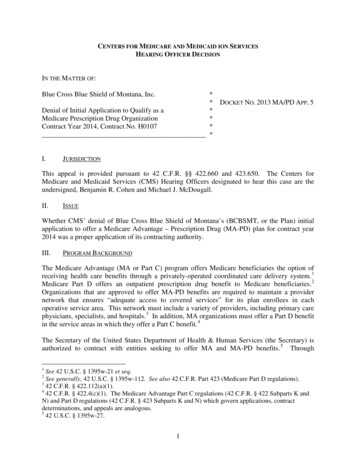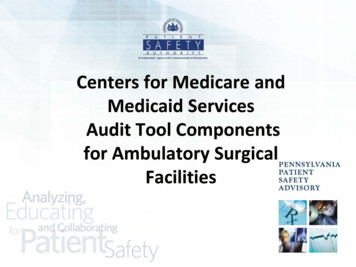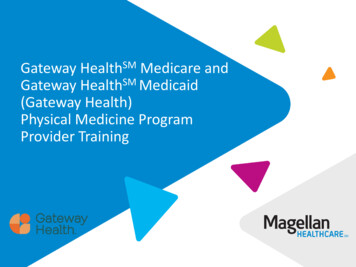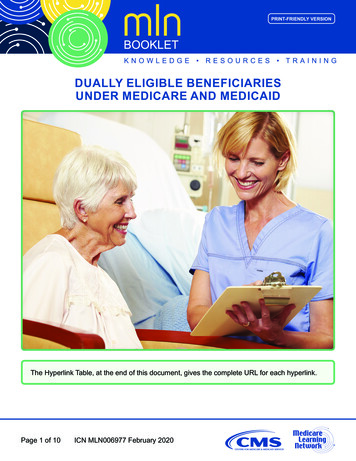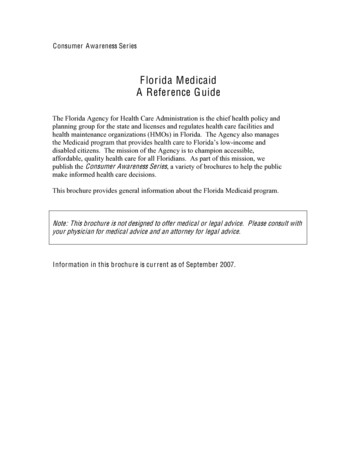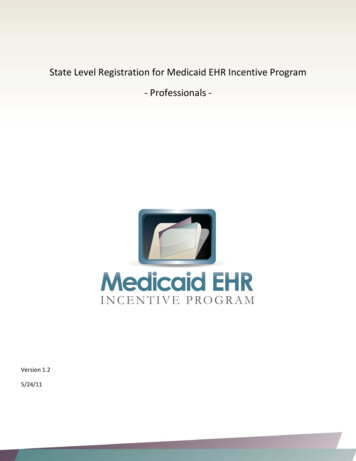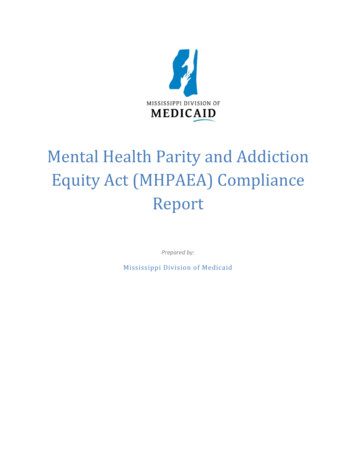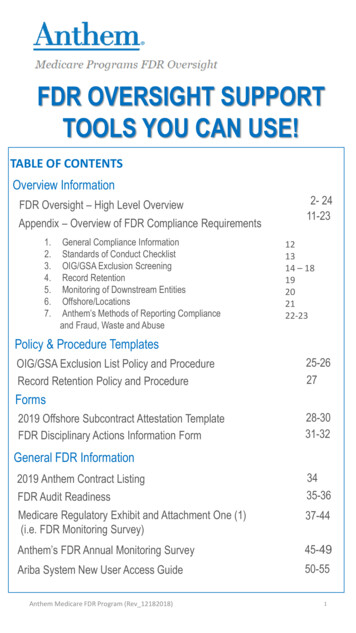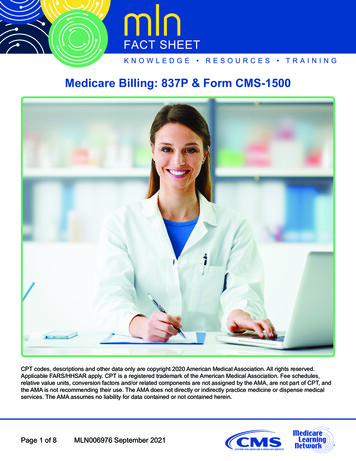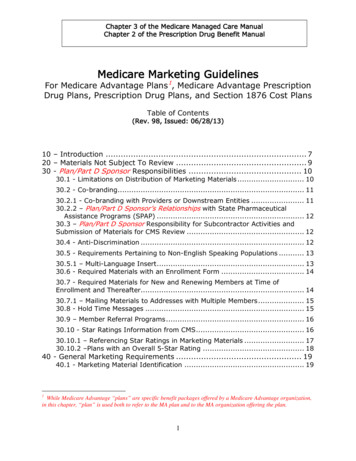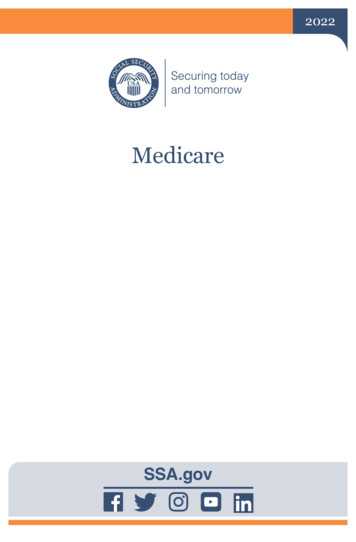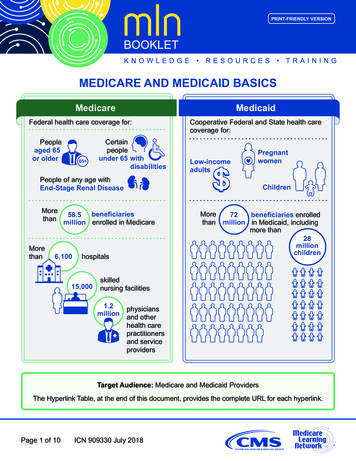
Transcription
PRINT-FRIENDLY VERSIONMEDICARE AND MEDICAID BASICSMedicareFederal health care coverage for:Certainpeopleunder 65 withdisabilitiesPeopleaged 65or olderMedicaidCooperative Federal and State health carecoverage for:Low-incomeadultsPregnantwomenPeople of any age withEnd-Stage Renal DiseaseMore58.5 beneficiariesthan million enrolled in beneficiaries enrolledthan million in Medicaid, includingmore than28millionchildrenskillednursing facilities1.2physiciansmillionand otherhealth carepractitionersand serviceprovidersTarget Audience: Medicare and Medicaid ProvidersThe Hyperlink Table, at the end of this document, provides the complete URL for each hyperlink.Page 1 of 10ICN 909330 July 2018
Medicare and Medicaid BasicsMLN BookletTABLE OF CONTENTSQuick Facts. 3Beneficiaries. 4Dual Eligible Beneficiaries. 5Covered Services. 5Other Common Types of Coverage. 6Resources. 7General Information. 7Provider Enrollment. 7Billing and Claims Submission. 7Payment. 8Appeals. 8Program Integrity. 8Program Guidance. 8Page 2 of 10ICN 909330 July 2018
Medicare and Medicaid BasicsMLN BookletThe Centers for Medicare & Medicaid Services (CMS) administers Medicare and Medicaid along withother Federal health care programs and services. This booklet provides an overview of the Medicareand Medicaid Programs and some brief information on other types of health coverage.QUICK FACTSMedicareMedicaidMedicare is a national program administeredby the Federal government, comprising:Medicaid is a network of Statewide programsadministered by State governments followingbroad national guidelines established byFederal statutes, regulations, and policies. Part A – Hospital InsuranceInpatient hospital, inpatient skillednursing facility, hospice, and some homehealth services Part B – Medical InsurancePhysician services, outpatient care,durable medical equipment, home healthservices, and many preventive services Part C – Medicare Advantage (MA)Medicare-approved private insurancecompanies that provide all Part Aand Part B services and may provideprescription drug coverage and othersupplemental benefits Part D – Prescription Drug BenefitMedicare-approved private insurancecompanies that provide outpatientprescription drug coverageHealth care coverage for: People 65 or older People with certain disabilities People diagnosed with end-stage renaldisease (ESRD)Medicare is the nation’s largest payer ofinpatient hospital services for the elderlyand people with ESRD.Page 3 of 10ICN 909330 July 2018Health care coverage for: Low-income adults Pregnant women ChildrenEligibility varies from State to State.Medicaid is the nation’s largest payer ofmental health services, long-term careservices, and births. Medicaid pays for40 percent of all births.
Medicare and Medicaid BasicsMLN BookletBENEFICIARIESMedicareHealth insurance for: People 65 and older People younger than age 65 with certaindisabilities entitled to Social Securitydisability or Railroad Retirement Boardbenefits for 24 months (the 24-monthwaiting period is waived for people withamyotrophic lateral sclerosis [ALS], alsoknown as Lou Gehrig’s disease) People of any age with ESRDMedicaidIndividuals must meet eligibility requirementsand State rules.Federal law requires States to cover certaineligibility groups and gives them the flexibilityto cover others.All States cover eligibility groups that servethe following populations: Children and adolescents Parents or caretaker relative ofminor children Certain people with disabilities or blindness Pregnant women Seniors Youth “aging out” of foster careFor many eligibility groups, individuals mustmeet certain resource limits.In addition, individuals must meet State andFederal requirements for: Immigration status Residency U.S. citizenshipPage 4 of 10ICN 909330 July 2018
Medicare and Medicaid BasicsMLN BookletDual Eligible Beneficiaries“Dual eligible beneficiaries” generally describes beneficiaries eligible for both Medicare andMedicaid. The term includes beneficiaries enrolled in Medicare Part A, Part B, or both andreceiving full Medicaid benefits or assistance with Medicare premiums or cost sharing through oneof these Medicare Savings Program (MSP) eligibility groups: Qualified Medicare Beneficiary (QMB) Program: Helps pay premiums, deductibles,coinsurance, and copayments for Part A, Part B, or both programs Specified Low-Income Medicare Beneficiary (SLMB) Program: Helps pay Part B premiums Qualifying Individual (QI) Program: Helps pay Part B premiums Qualified Disabled Working Individual (QDWI) Program: Pays the Part A premium forcertain disabled and working beneficiaries who have disabilitiesFor more information, refer to the Dual Eligible Beneficiaries Under Medicare and Medicaid booklet.COVERED SERVICESMedicareBeneficiaries may choose coverage as follows: Part A and Part B services through theOriginal Medicare Program with optionalPart D coverage through a stand-alonePrescription Drug Plan Part A and Part B services through anMA Plan if they reside in its service area,with Part D coverage included in someMA PlansNote: Some beneficiaries get a Medicaresupplement plan (also called Medigap)for expanded coverage in the OriginalMedicare ProgramPage 5 of 10ICN 909330 July 2018MedicaidSome Medicaid Programs pay for caredirectly. Others use private insurancecompanies to provide Medicaid coverage.States must cover certain services throughtheir Medicaid Program, including: Doctor visits Inpatient and outpatient hospital services Mental health services Needed medications Prenatal care and maternity care Preventive care, such as immunizations,mammograms, and colonoscopies
Medicare and Medicaid BasicsMLN BookletCOVERED SERVICES (CONT.)MedicarePart A helps cover: Inpatient hospital care Skilled nursing facility care Hospice care Home health carePart B helps cover: Services from doctors and other healthcare providers Outpatient careMedicaidStates may choose to cover addedservices. Some of these include: Dental services Home and community-based services Physical therapy Prosthetic devices Vision and eyeglasses Home health care Durable medical equipmentChildren and adolescents get vision,dental, hearing, and other servicesthrough the Medicaid Early andPeriodic Screening, Diagnostic, andTreatment (EPSDT) benefit Many preventive servicesPart C includes all benefits and servicescovered under Part A and Part B and mayinclude extra benefits and services for anextra cost.Part D helps cover the cost ofprescription drugs.OTHER COMMON TYPES OF COVERAGEYou may encounter patients with health care coverage other than Medicare or Medicaid. Theseprograms include: Private insurance coverage (such as group health plan or retiree coverage)TRICARECOBRAWorkers’ Compensation Liability insurance coverageFor more information on these types of coverage, take the Medicare Secondary Payer Provisionsweb-based training course. Need help accessing the course? Find information in The MedicareLearning Network (MLN) Learning Management System (LMS) FAQs booklet.Page 6 of 10ICN 909330 July 2018
Medicare and Medicaid BasicsMLN BookletRESOURCESGeneral InformationMedicareMedicaidFind additional resources about the MedicareProgram on the Medicare.gov website.Find additional resources about the MedicaidProgram on the Medicaid.gov website.The Social Security Administration processesMedicare enrollment applications.Contact your State Medicaid office with questions.The searchable Medicare Coverage Databaseallows you to learn about any national and localdeterminations regarding coverage for specificmedical services.See if your patient qualifies for Extra Help WithMedicare Prescription Drug Plan Costs.See if your patient qualifies for Medicaid in yourState based on income alone using the Medicaid& CHIP Coverage tool.Share easy-to-read infographics on commonMedicaid questions or find key messagesand tips from the Medicaid Program IntegrityEducation webpage.Provider EnrollmentMedicareMedicaidFind health care professional-specific information Find more information about your State’s Medicaidabout enrolling in Medicare through MLNProgram on the State Overviews webpage.provider-supplier enrollment educational products.Billing and Claims SubmissionMedicareFind information about submitting Medicareclaims in the Medicare Billing: 837I and FormCMS-1450 and the Medicare Billing: 837P andForm CMS-1500 publications.MedicaidWhile each State Medicaid Program varies,general rules require that you: Bill only for covered services Ensure beneficiaries are eligible for serviceswhere they are furnished Ensure medical records are accurate, legible,signed, and dated Return any overpayments within 60 daysFind more information about your State’s MedicaidProgram on the State Overviews webpage.Page 7 of 10ICN 909330 July 2018
Medicare and Medicaid BasicsMLN BookletPaymentMedicareMedicaidFind information about payment for your provider Find more information about your State’stype on the MLN Publications webpage. EnterMedicaid Program on the State Overviews“Medicare Payment Policy” in the Filter field.webpage.AppealsMedicareMedicaidFind information about Medicare appeals in theMedicare Parts A & B Appeals Process booket andthe two web-based trainings “Part C OrganizationDeterminations, Appeals, & Grievances” and“Part D Coverage Determinations, Appeals, &Grievances” on the MLN LMS.Find more information about your State’sMedicaid Program on the State Overviewswebpage.Program IntegrityMedicareMedicaidFind information about compliance and fraud,waste, and abuse on the MLN ProviderCompliance webpage.Find information about program integrity in theMedicaid Program on the Medicaid ProgramIntegrity Education webpage. Find moreinformation about your State’s Medicaid Programon the State Overviews webpage.Program GuidanceMedicareVisit the CMS Regulations & Guidance webpagefor information on rulings, transmittals, manuals,and other guidance.MedicaidCMS issues guidance to State Medicaiddirectors, State health officials, and otherstakeholders regarding Medicaid operationalissues. This guidance comes through letters,MLN Matters Articles are national articles thatinformational bulletins, and frequently askedinform health care professionals about the latestquestions. CMS also issues Federal regulationschanges to CMS programs.that codify statutory provisions and policies thatSign up for MLN electronic mailing lists and access have been previously outlined in subregulatoryMLN Connects newsletters on the MLN News & guidance. Search these documents on theUpdates website.Medicaid Federal Policy Guidance webpage.Page 8 of 10ICN 909330 July 2018
Medicare and Medicaid BasicsMLN BookletHyperlink TableEmbedded HyperlinkComplete URLCMS Regulations & ce/Regulations-and-Guidance.htmlContact Your State Medicaid OfficeWith -us/contact-state-page.htmlDual Eligible Beneficiaries Under Medicareand lications-Items/CMS1244469.htmlEasy-To-Read Infographics on CommonMedicaid ion/infographics.htmlExtra Help With Medicare Prescription DrugPlan Costshttps://secure.ssa.gov/i1020/startKey Messages and ey-messages-and-tips.htmlMedicaid & CHIP Coverage id Early and Periodic Screening,Diagnostic, and Treatment pdfMedicaid Federal Policy danceMedicaid Program Integrity ion/edmic-landing.htmlMedicare Billing: 837I and Form lications-Items/ICN006926.htmlMedicare Billing: 837P and Form lications-Items/ICN006976.htmlPage 9 of 10ICN 909330 July 2018
Medicare and Medicaid BasicsMLN BookletHyperlink Table (cont.)Embedded HyperlinkComplete URLMedicare Coverage baseMedicare Parts A & B Appeals ications-Items/CMS1243294.htmlMedicare Secondary Payer Provisionshttps://learner.mlnlms.comMLN LMShttps://learner.mlnlms.comMLN Matters LN News & Outreach/FFSProvPartProg/Index.htmlMLN Provider derCompliance.htmlMLN Provider-Supplier Enrollment rSupEnroll/Downloads/Medicare ProviderSupplier Enrollment National EducationProducts.pdfMLN -Publications.htmlSocial Security eState he Medicare Learning Network (MLN)Learning Management System (LMS) tions-Items/ICN909182.htmlMedicare Learning Network Product DisclaimerThe Medicare Learning Network , MLN Connects , and MLN Matters are registered trademarks of the U.S. Departmentof Health & Human Services (HHS).Page 10 of 10ICN 909330 July 2018
disabilities entitled to Social Security disability or Railroad Retirement Board benefits for 24 months (the 24-month waiting period is waived for people with amyotrophic lateral sclerosis [ALS], also known as Lou Gehrig’s disease) People of any age with ESRD Medicaid Individu
